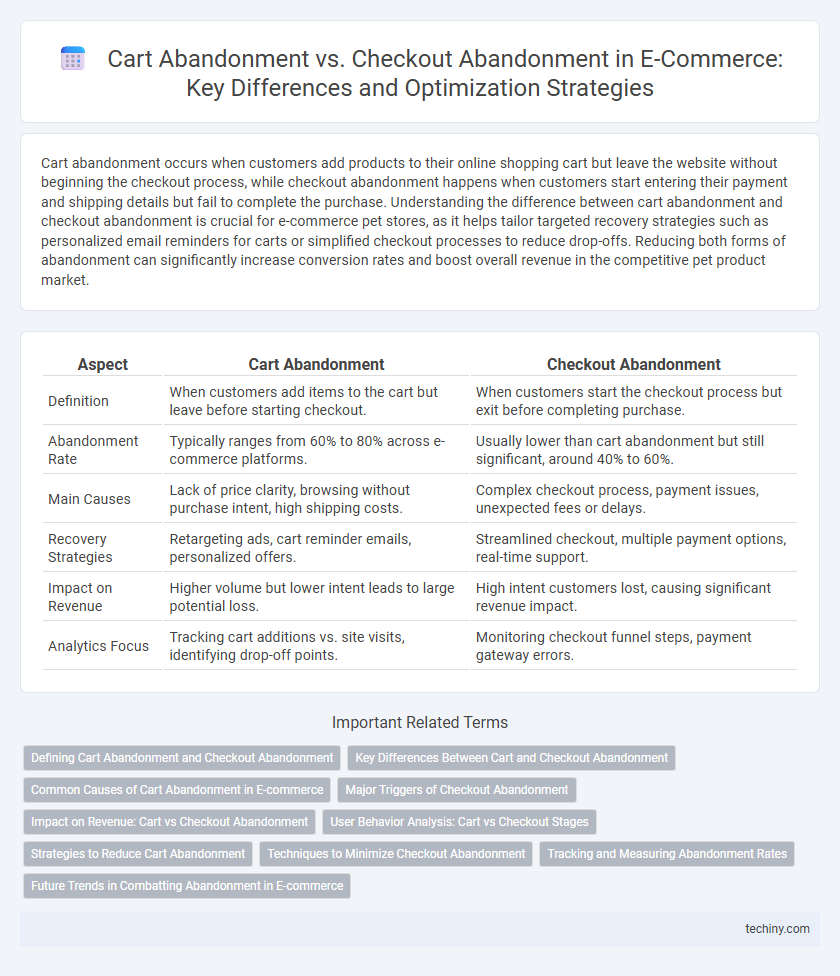Cart abandonment occurs when customers add products to their online shopping cart but leave the website without beginning the checkout process, while checkout abandonment happens when customers start entering their payment and shipping details but fail to complete the purchase. Understanding the difference between cart abandonment and checkout abandonment is crucial for e-commerce pet stores, as it helps tailor targeted recovery strategies such as personalized email reminders for carts or simplified checkout processes to reduce drop-offs. Reducing both forms of abandonment can significantly increase conversion rates and boost overall revenue in the competitive pet product market.
Table of Comparison
| Aspect | Cart Abandonment | Checkout Abandonment |
|---|---|---|
| Definition | When customers add items to the cart but leave before starting checkout. | When customers start the checkout process but exit before completing purchase. |
| Abandonment Rate | Typically ranges from 60% to 80% across e-commerce platforms. | Usually lower than cart abandonment but still significant, around 40% to 60%. |
| Main Causes | Lack of price clarity, browsing without purchase intent, high shipping costs. | Complex checkout process, payment issues, unexpected fees or delays. |
| Recovery Strategies | Retargeting ads, cart reminder emails, personalized offers. | Streamlined checkout, multiple payment options, real-time support. |
| Impact on Revenue | Higher volume but lower intent leads to large potential loss. | High intent customers lost, causing significant revenue impact. |
| Analytics Focus | Tracking cart additions vs. site visits, identifying drop-off points. | Monitoring checkout funnel steps, payment gateway errors. |
Defining Cart Abandonment and Checkout Abandonment
Cart abandonment occurs when shoppers add items to their online shopping cart but leave the site without initiating the checkout process. Checkout abandonment takes place when customers begin the checkout process by entering personal or payment information but fail to complete the purchase. Understanding the distinction between cart abandonment and checkout abandonment helps e-commerce businesses optimize conversion strategies and reduce lost sales.
Key Differences Between Cart and Checkout Abandonment
Cart abandonment occurs when shoppers add products to their online cart but leave before initiating the checkout process, while checkout abandonment happens after customers start entering payment or shipping information but fail to complete the purchase. Key differences include the stage in the purchase funnel where abandonment occurs and the types of friction experienced, such as price concerns during cart abandonment versus form complexity or payment issues during checkout abandonment. Understanding these distinctions helps e-commerce businesses tailor recovery strategies like remarketing for cart abandoners and streamlining checkout UX for those abandoning during payment.
Common Causes of Cart Abandonment in E-commerce
High shipping costs, complicated checkout processes, and lack of payment options are the most common causes of cart abandonment in e-commerce. Slow website loading times and unexpected additional fees during checkout also significantly contribute to users leaving their carts. Improving site speed, transparent pricing, and streamlined checkout can reduce abandonment rates and boost conversions.
Major Triggers of Checkout Abandonment
High shipping costs, complicated checkout processes, and lack of multiple payment options are major triggers of checkout abandonment in e-commerce. Unexpected additional fees at the final stage cause frustration, leading many users to leave without completing their purchase. Ensuring transparent pricing, streamlined checkout flow, and diverse payment methods can significantly reduce checkout abandonment rates.
Impact on Revenue: Cart vs Checkout Abandonment
Cart abandonment causes significant revenue loss, with up to 70% of online shopping carts left unpurchased, directly impacting potential sales volume. Checkout abandonment, occurring later in the purchasing funnel, often represents higher intent customers, resulting in even greater impact on revenue per lost transaction. Reducing both abandonment rates through targeted strategies can substantially improve conversion rates and overall e-commerce profitability.
User Behavior Analysis: Cart vs Checkout Stages
Analyzing user behavior during cart and checkout stages reveals distinct abandonment patterns essential for optimizing e-commerce conversion rates. Cart abandonment often occurs due to price sensitivity, comparison shopping, or lack of trust, while checkout abandonment is frequently driven by complicated forms, unexpected costs, or payment issues. Leveraging analytics tools to track drop-off points and personalize interventions based on stage-specific friction can significantly reduce abandonment rates and enhance the overall shopping experience.
Strategies to Reduce Cart Abandonment
Reducing cart abandonment requires personalized email reminders, simplified checkout processes, and clear shipping information to encourage customers to complete their purchase. Implementing exit-intent popups and offering limited-time discounts increases urgency and recaptures potential buyers before they leave. Optimizing mobile checkout experiences and providing multiple payment options also significantly lower cart abandonment rates in e-commerce platforms.
Techniques to Minimize Checkout Abandonment
Effective techniques to minimize checkout abandonment include streamlining the payment process by offering multiple secure payment options and ensuring a mobile-friendly interface. Implementing real-time customer support, such as live chat or chatbot assistance, helps resolve last-minute concerns that may block purchase completion. Additionally, providing clear shipping information and transparent costs upfront reduces uncertainty and increases buyer confidence at checkout.
Tracking and Measuring Abandonment Rates
Tracking cart abandonment involves monitoring when customers add items to their shopping cart but leave before initiating checkout, while checkout abandonment measures users who start the checkout process but fail to complete the purchase. Employing analytics tools like Google Analytics and specialized e-commerce platforms allows precise measurement of abandonment rates by capturing user behavior at each stage. Accurate tracking enables businesses to identify friction points, optimize the user experience, and implement targeted remarketing strategies to reduce revenue loss.
Future Trends in Combatting Abandonment in E-commerce
Future trends in combatting cart abandonment and checkout abandonment in e-commerce emphasize personalized AI-driven recovery strategies and seamless omnichannel experiences. Advanced predictive analytics enable retailers to identify high-risk abandonment points, allowing targeted interventions such as dynamic retargeting and personalized discount offers. Integration of augmented reality (AR) and voice commerce is also poised to reduce abandonment rates by enhancing user engagement and streamlining the checkout process.
Cart Abandonment vs Checkout Abandonment Infographic

 techiny.com
techiny.com